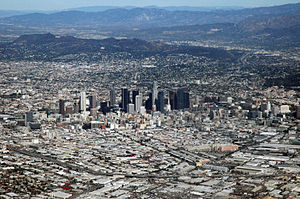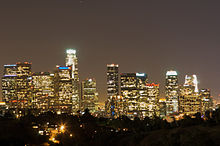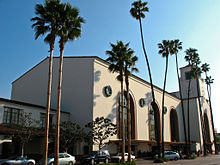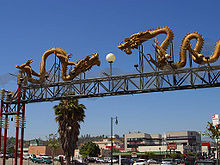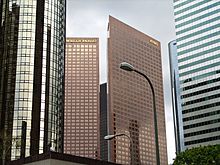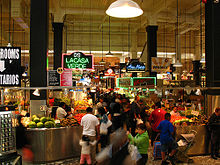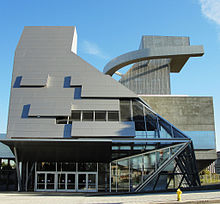- Downtown Los Angeles
-
Downtown Los Angeles — Neighborhood of the City of Los Angeles — Downtown skyline during sunset as seen from Griffith Observatory, October 2006. 
Flag
SealNickname(s): Downtown L.A. Freeway map of the Los Angeles area showing Downtown L.A. Coordinates: 34°03′25″N 118°14′17″W / 34.057°N 118.238°WCoordinates: 34°03′25″N 118°14′17″W / 34.057°N 118.238°W Country  United States
United StatesState  California
CaliforniaCounty County of Los Angeles City  Los Angeles
Los AngelesSubdistricts of Downtown Government – City Council Jan Perry, Jose Huizar – State Assembly John Pérez (D) – State Senate Gil Cedillo (D) – U.S. House Lucille Roybal-Allard (D) Area[1] – Total 5.305 sq mi (8.538 km2) Population (2008)[2] – Total 39,537 ZIP codes 90012, 90013, 90014, 90015, 90016, 90017, 90021, and 90071 Website downtownla.com Downtown Los Angeles is the central business district of Los Angeles, California, United States, located close to the geographic center of the metropolitan area. The area features many of the city's major arts institutions and sports facilities, sightseeing opportunities, a variety of skyscrapers and associated large multinational corporations and an array of public art and unique shopping opportunities. Downtown is the hub of the city's freeway network and Metro rapid transit system.
Though Downtown is generally thought to be bounded by the Los Angeles River on the east in Lincoln Heights, the Hollywood (101) Freeway to the north, the Santa Monica (10) Freeway on the south and the Harbor (110) Freeway on the west, some sources, including the Los Angeles Downtown News and Los Angeles Times,[3] extend the area past the traditional boundary to include University Park and Exposition Park, encompassing the University of Southern California (USC) and Central City West neighborhoods.
Contents
History
Early years
The earliest known settlements in the area of what is now Downtown Los Angeles was by the Tongva, a Native American people. Later European settlement arrived after Father Juan Crespí, a Spanish missionary charged with exploring sites for Catholic missions in California, noted in 1769 that the region had "all the requisites for a large settlement."[4] On September 4, 1781, the city was founded on the site that currently holds La Placita Olvera.
Land speculation increased in the 1880s, which saw the population of the city explode from 11,000 in 1880 to nearly 100,000 by 1896.[5]
Infrastructure enhancements and the laying of a street grid eventually brought development south of the original settlement into what is today the Civic Center and Historic Core neighborhoods.
Downtown's golden age
By 1920, the city's private and municipal rail lines were among the most far-flung and most comprehensive in the world in mileage, rivaling that of New York City, as shown (and parodied) in the 1988 film Who Framed Roger Rabbit. By that year, a steady influx of residents and aggressive land developers had transformed the city into a large metropolitan area, with Downtown at its center. Rail lines connected four counties with over 1,100 miles (1,800 km) of track.[6]
During the early part of the 20th century, banking institutions clustered around South Spring Street, forming the Spring Street Financial District. Sometimes referred to as the "Wall Street of the West,"[7] the district held corporate headquarters for financial institutions including Bank of America, Farmers and Merchants Bank, the Crocker National Bank, California Bank & Trust, and International Savings & Exchange Bank. The Los Angeles Stock Exchange was also located on the corridor from 1929 until 1986 before moving into a new building across the Harbor (110) Freeway.[8]
Commercial growth brought with it hotel construction—during this time period several grand hotels, the Alexandria (1906), the Rosslyn (1911), and the Biltmore (1923), were erected—and also the need for venues to entertain the growing population of Los Angeles. Broadway became the nightlife, shopping and entertainment district of the city, with over a dozen movie houses built before 1932.
Department stores also opened flagship stores in Downtown, including The Broadway, Hamburger & Sons, May Company, JW Robinson's and Bullock's, serving a wealthy residential population in the Bunker Hill neighborhood. Numerous specialty stores also flourished including those in the jewelry business which gave rise to the Downtown Jewelry District. Among these early Jewelers included the Laykin Diamond Company (later becoming Laykin et Cie [1]) and Harry Winston & Co. both of which found their beginnings in the Alexandria Hotel at 5th and Spring Streets.
The Los Angeles Union Passenger Terminal (Union Station) opened in May, 1939, unifying passenger service among various local, regional and long-distance passenger trains.
Decline and redevelopment
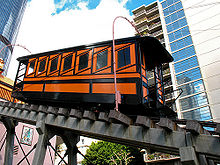 Angels Flight. November 2008
Angels Flight. November 2008
Following World War II, suburbanization, the development of the Los Angeles freeway network and, subsequently, increased automobile ownership, led to decreased investment in Downtown. Many corporate headquarters slowly dispersed to new suburbs or fell to mergers and acquisitions. The once-wealthy Bunker Hill neighborhood became a haven for low-income renters, its stately Victorian mansions turned into flophouses. From about 1930 to the 1960s, numerous very old and historic buildings in the Plaza area were demolished to make way for street-level parking lots, the high demand for parking making this more profitable than any other option that might have allowed preservation. The drastic reduction in the number of residents in the area further reduced the viability of streetfront businesses that would be able to attract pedestrians. For most Angelenos, Downtown became a drive-in-drive-out destination as they would come into the area for a particular objective, and then leave immediately once their business was completed.
In an effort to combat blight and lure businesses back to Downtown, the Community Redevelopment Agency of the city of Los Angeles undertook the Bunker Hill Redevelopment Project in 1955, a massive clearance project that leveled homes and cleared land for future commercial skyscraper development. This period saw the clearing and upzoning of the entire neighborhood as well as the shuttering of the Angels Flight funicular railway in 1969. Angels Flight resumed operation in 1996 for a period of five years, shutting down once again after a fatal accident in 2001. On March 15, 2010, the railway once again opened for passenger service following extensive upgrades to brake and safety systems.
With Class A office space becoming available on Bunker Hill, many of Downtown's remaining financial corporations moved to the newer buildings, leaving the former Spring Street Financial District devoid of tenants above ground floor. Following the corporate headquarters' moving six blocks west, the large department stores on Broadway shuttered, culminating in the 1980s.
However, the Broadway theaters saw much use as Spanish-language movie houses during this time, beginning with the conversion of the Million Dollar Theater in the 1950s to Spanish-language film.[9]
Recent years
 The U.S. Bank Tower in Downtown L.A. is the tallest building in the U.S. west of the Mississippi River (1,018 feet or 310 meters)
The U.S. Bank Tower in Downtown L.A. is the tallest building in the U.S. west of the Mississippi River (1,018 feet or 310 meters)
Because of the Downtown office market's migration west to Bunker Hill and the Financial District, many historic office buildings were left intact, simply used for storage or remaining empty during recent decades. In 1999, the Los Angeles City Council passed an adaptive reuse ordinance, making it easier for developers to convert outmoded, vacant office and commercial buildings into renovated lofts and luxury apartment and condo complexes.
As of early 2009, 14,561 residential units[10] have been created under the adaptive reuse ordinance, leading to an increase in the residential population. With 28,878 residents in 2006[11] and 39,537 in 2008,[2] a 36.9% increase, Downtown Los Angeles is seeing new life and investment.[12]
- Staples Center, which opened in 1999, has contributed immensely to the revitalization plans, adding 250 events and nearly 4,000,000 visitors per year to the neighborhood.[13]
- A growing rail transit network centered in Downtown has increased mobility and access to jobs throughout the region.
- On August 7, 2007, the Los Angeles City Council approved sweeping changes in zoning and development rules for the Downtown area.[3] Strongly advocated by Mayor Antonio Villaraigosa, the changes allow larger and denser developments Downtown; developers who reserve 15% of their units for low-income residents are now exempt from some open-space requirements and can make their buildings 35% larger than current zoning codes allow.[3]
Projects along the Figueroa Corridor such as Wilshire Grand Tower I are also being approved that will further the progressive revitalization of downtown; attracting businesses, tourists and new residents, and rivaling other spots, like Times Square. With the addition of new skyscrapers such as the Wilshire Towers, Downtown is slated to have a skyline in prominence rivaling those ranked among the top in the world.[14]
Neighborhoods and attractions
Pueblo (Union Station and Olvera Street)
- On the northeastern edge of Downtown Los Angeles, the bustling Los Angeles Union Station (known as the "Last of the Great Railway Stations") serves as the region's main transportation hub, with the convergence of six commuter rail lines, two subway lines, a light rail line, Amtrak service and multiple local and regional bus services. The station, opened May 1939, is a massive building in the Art Deco, Moorish and Spanish Mission styles, that serves a growing rail and bus passenger market. Station grounds include soaring ceilings, deep leather-and-wood chairs, and two adjoining greenspaces and fountains flanking the main passenger concourse. The Los Angeles Conservancy offers guided tours of Union Station for a small fee.
- Across Alameda Street from Union Station is the historic center of the city, El Pueblo de Los Angeles, enshrined as Olvera Street, a collection of historic shops, restaurants and several museums, as well as La Placita Olvera and Our Lady Queen of the Angels Church.
- The Old Plaza Firehouse is a museum dedicated to historic firefighting artifacts and memorabilia, including historical maps of the city of Los Angeles.
- The Chinese American Museum is located in the historic Garnier Building and features exhibits detailing the lives of Chinese Americans in early California as well as contemporary works by Chinese American artists.
- Philippe the Original, a 1908 eatery that lays a competing claim (along with Cole's Pacific Electric Buffet) to the invention of the French dip sandwich, is among the oldest eateries in the city.
Chinatown
North and west of Union Station lies Chinatown, a mixed-use district of restaurants, nightlife, art galleries, trinket shops, a branch of the Los Angeles Public Library system and residences. The neighborhood is accessible via the Metro Gold Line Chinatown Station.
- Centered along North Broadway and North Hill Street, Chinatown Central Plaza, also known as "New Chinatown," is the central gathering place in the neighborhood.
- Operated by the Chinese Historical Society of Southern California, the Chinatown Heritage & Visitors Center is open to the public and aims to share the Chinese-American history of the Los Angeles area.
- Los Angeles State Historic Park, Downtown's largest greenspace, lies north of the light rail station on North Spring Street.
Little Tokyo
Despite the suburbanization of Southern California's Japanese Americans over the past several decades, Little Tokyo remains the cultural heart of the Japanese American community. The neighborhood is home to several Buddhist temples, dozens of shops, restaurants and taverns, two museums, and a branch of the Los Angeles Public Library system.
Little Tokyo is accessible via the nearby Metro Red/Purple Line Civic Center Station, and the Little Tokyo light-rail station on the Metro Gold Line.
- Pedestrian activity in the neighborhood is centered around the Japanese Village Plaza, an open-air shopping area spanning First and Second streets. The center is home to Nijiya Market, Mikawaya Ice Cream, Yamazaki Bakery and several other stores and eateries, as well as a landmark watchtower on First Street.
- Historic First Street is an active restaurant row, with many establishments specializing in Japanese ramen noodles. Fugetsu-do, a century-old establishment that specializes in mochi, a Japanese rice-based snack, is located on this corridor.
- Weller Court is a retail complex anchored by Marukai Market at the intersection of Second and San Pedro streets. Three levels of Japanese-themed shops and restaurants face an interior courtyard. The shopping center also features a memorial to the seven crewmembers killed in the Space Shuttle Challenger disaster.
- The Japanese American National Museum (JANM) is Little Tokyo's largest cultural facility and plays host to several exhibits detailing the plight of Japanese American citizens during the World War II era, as well as historical perspectives and contemporary works by Japanese American artists.
- Little Tokyo is home to a secondary campus of the Museum of Contemporary Art (MOCA), the Geffen Contemporary.
Civic Center
 Los Angeles City Hall, 2009.
Los Angeles City Hall, 2009.
 The DWP John Ferraro Building
The DWP John Ferraro Building
 Walt Disney Concert Hall, Bunker Hill
Walt Disney Concert Hall, Bunker Hill
Los Angeles's Civic Center is the government center of the city and is home to several federal, state, county and municipal administrative buildings. The main office of the Los Angeles Times is located in the district. The neighborhood is accessible via the Metro Red/Purple Line Civic Center Station.
- The new Los Angeles Police Department Police Administration Building, designed by DMJM Architects, replaced the aging Parker Center, which is slated for demolition. A public park is located on the Second Street side of the building.
- As part of the Caltrans District 7 Headquarters project, a public art project was placed in the entrance plaza. The large-scale artwork uses a series of neon tubes to mimic the flow of traffic on a freeway.
- The Los Angeles Mall (park) stretches between City Hall on the east and the Los Angeles Music Center on adjoining Bunker Hill. Plans call for a 16-acre (65,000 m2) replacement park[15] designed by Rios Clementi Hale Studios. The plan includes a large community gathering space at the foot of City Hall, new gardens and green space between the Los Angeles County Hall of Administration and the court houses, and an overhaul of an existing fountain.
- An observation deck on the 27th floor of City Hall is open to the public on weekdays.
Bunker Hill
Bunker Hill is the cultural heart of Los Angeles, with several arts schools, theaters and performance venues along Grand Avenue. Guided tours of the neighborhood are provided by the Los Angeles Conservancy for a small fee. The neighborhood is accessible via the Metro Red/Purple Line Civic Center Station.
- Central Los Angeles Area High School Number 9, a new performing arts school on Grand Avenue, is scheduled to open in September 2009. At $232 million,[16] the high school is among the most expensive ever built in the United States and features a futuristic post-Modern design by Austrian architecture firm Coop Himmelb(l)au. The project is noted for its conical theater, spiral tower facing the 101 Freeway and glass-and-steel entryway on Grand Avenue.
- Acting as the headquarters of the Los Angeles Archdiocese, the Cathedral of Our Lady of the Angels at Grand Avenue and Temple Street was completed in 2002 after the nearby St. Vibiana's Cathedral was damaged in the 1994 Northridge earthquake. The 58,000-square-foot (5,400 m2) complex can hold 3,000 attendees and was designed by Spanish architect Rafael Moneo in a post-Modern style. A plaza and small park are open to the public.
- The Los Angeles Music Center is a complex of music and theatrical halls on the Grand Avenue cultural corridor between Temple Street to the north and Second Street to the south, including the Dorothy Chandler Pavilion, Mark Taper Forum, Ahmanson Theater and Walt Disney Concert Hall. The Disney Hall opened in 2003 as the new home of the Los Angeles Philharmonic and the Los Angeles Master Chorale, increasing the number of major theaters at the Music Center to four. Also housed in the Disney Hall complex is the smaller REDCAT Theater and art studio. Audio and guided tours are provided by the Music Center.
- Architecture firm A.C. Martin designed the 1964 Los Angeles Department of Water and Power headquarters building at the intersection of First and Hope streets, which was later renamed the John Ferraro Building after the late City Councilman John Ferraro. It is noted for its iconic modern architecture and backlit fountains.
- South of the Music Center is the Museum of Contemporary Art (MOCA), the only museum in Los Angeles dedicated solely to contemporary artworks produced after 1940.
- The Colburn School of Performing Arts is a leading performance and music school, consisting of the School of Performing Arts and the Conservatory of Music.
- Dining and performances are available at the Water Court at California Plaza. Free outdoor concerts are scheduled during the summer, operated by the nonprofit Grand Performances. Several new restaurants have opened in the area in recent years.
- The historic Angels Flight funicular railway sits at the eastern portion of California Plaza. Re-opened in 2010, the twin rail cars Olivet and Sinai serve the Historic Core neighborhood. On a steep incline of Bunker Hill, the railway previously ran from 1901 to 1969, and 1969 to 2001.
Historic Core
The Historic Core neighborhood is a heavily residential neighborhood of Downtown Los Angeles, and many of those residences are adaptive reuse loft units created from formerly vacant historic commercial and office buildings. Guided tours of the Historic Core are offered by the Los Angeles Conservancy for a small fee.
The neighborhood is accessible via the Metro Red/Purple Line Pershing Square Station.
- The Old Bank District, centered around Fourth and Main streets, is a mixed-use loft district, with many of the historic buildings being converted to residential use under the city's adaptive reuse ordinance. At the same time, a growing number of restaurants, coffee shops, and bars are contributing toward the revitalization of this neighborhood.
- Downtown's Gallery Row is a city-recognized art gallery district in the Historic Core. Starting with three art galleries in 2003, Gallery Row claimed 50 art galleries as of 2009.[17] The Downtown Art Walk is held on the Second Thursday of every month from 12 - 9 pm, and attracts nearly 5,000 attendees.[18]
- The Bradbury Building, built in 1893, is the oldest office building in Los Angeles and features an interior courtyard with intricate wrought-iron staircases and railings, and a glass-and-iron ceiling.
- Grand Central Market, an open-air produce market and food court, captures a multi-ethnic, early-1900s feel, with vendors selling produce, spices, and ethnic meals in the ground floor of the 1905 Homer Laughlin Building.
- Cole's is the oldest existing restaurant in Los Angeles, opening in 1908.[19] Known for its French dip sandwiches, along with Philippe's to the north, the restaurant and bar recently underwent a renovation with a new kitchen, chef, and restored bar.
- The Broadway Theatre District is a collection of historic movie palaces, some of which are undergoing renovation for use as performance spaces. Guided tours of the neighborhood are offered by the Los Angeles Conservancy for a small fee.
Financial District
South of Bunker Hill is the Financial District of Downtown Los Angeles, the center for corporate headquarters and skyscrapers in Los Angeles. The neighborhood is accessible via the Metro Red/Purple/Blue Line 7th Street/Metro Center Station.
- The U.S. Bank Tower, formerly known as the Library Tower, is the seventh-tallest building in the United States, and the tallest building between Chicago and Auckland, New Zealand, at 310 m (1018 ft) tall. Designed by architect I.M. Pei and constructed in 1989, it was initially called Library Tower because the purchase of air rights from the Los Angeles Central Library, located across the street. The air rights purchase allowed a building of such height to be built and paid for a renovation and expansion of the Central Library.[20]
- After suffering two arson fires in 1986, money from air rights purchased for the construction of the Library Tower was used toward expanding and renovating the Richard Riordan Central Library, which was built in 1926 in ancient Egyptian revival style. The library is the third largest in the United States. An ornate rotunda and exhibition gallery greet visitors on the second floor.
- Adjacent to the library is Maguire Gardens, a public greenspace and sculpture garden at the intersection of Fifth and Flower streets.
- At the base of Bunker Hill and the Library Tower lie the Bunker Hill Steps, a classically designed stairway consisting of 103 steps connecting the Financial District to Bunker Hill. The Bunker Hill Steps are often described as Los Angeles's version of Rome's "Spanish Steps."[21]
- The Millennium Biltmore Hotel is one of the grandest hotels in Los Angeles, opening in 1923. The Beaux-Arts-style architecture and several historic ballrooms are a draw for sightseers and tourists. Guided tours are offered by the Los Angeles Conservancy for a small fee.
South Park
 L.A. Live in Downtown Los Angeles
L.A. Live in Downtown Los Angeles
South Park is a growing residential and entertainment neighborhood consisting of the Los Angeles Convention Center, Staples Center and the mixed-use L.A. Live entertainment campus. The area has seen a revival due to an increase in new residential buildings and restaurants. The neighborhood is accessible via the Metro Blue Line Pico/Chick Hearn Station.
- The L.A. Live campus consists of over a dozen restaurants, an ESPN Zone arcade, the 7,100-seat Nokia Theatre, the 2,300-seat Club Nokia performance venue and nightclub, and the Latin-themed Conga Room nightclub.
- The Grammy Museum at L.A. Live opened in 2008 in conjunction with the 50th Anniversary of the Grammy Awards. The museum features many interactive exhibits, music memorabilia, and educational opportunities.
Central City East/Skid Row
Main article: Skid Row, Los AngelesThe Central City East district, also known as Skid Row, is a 50-block neighborhood in the center of Downtown Los Angeles, home to an estimated 17,740 residents, 1,797 of whom are considered unsheltered.[22] Homelessness is rampant throughout the district, as many mental health, drug rehabilitation and homeless housing services are concentrated nearby.
The unsheltered population of the district has fallen in recent months as supportive housing projects have opened to provide shelter and on-site services for the homeless or those at risk of homelessness. City and county-sponsored initiatives to increase access to housing has had an effect on the region's homeless population, with the most recent census recording a 38% drop in homelessness across Los Angeles.[23]
Although life is still difficult for homeless persons living in the area, the indicated district has in fact undergone rather radical transformations since the 1970s and 1980s, when conditions there were truly horrendous. Since then, most of the old hotels and tenement like apartments have been torn down and replaced with commercial real estate. In many cases the new buildings are now occupied by thriving businesses. In short, conditions in what is known as "Skid Row", are much better today than they have been in the past.
Other districts
Downtown contains other smaller or lesser known districts:
- Arts District
- Fashion District
- Jewelry District
- Toy District
- Warehouse District
As well as, a Seafood District and Produce District.
Public transportation
Local and regional service
 Current Los Angeles Metro system map showing existing rail and rapid transit lines.
Current Los Angeles Metro system map showing existing rail and rapid transit lines.
Downtown Los Angeles is the center of the region's growing rail transit system, with six commuter lines operated by Metrolink, and two subway lines, two light rail lines and local and regional bus service operated by Los Angeles County Metropolitan Transportation Authority (Metro).
Major subway and light rail stations in Downtown include Chinatown Station, Los Angeles Union Station, Civic Center Station, Pershing Square Station, 7th Street/Metro Center Station, Pico/Chick Hearn Station, and Little Tokyo/Arts District Station.
- The first leg of the modern Los Angeles metro rail system, the Metro Blue Line light rail, debuted in 1990, followed by the Metro Red Line subway in 1993 the Metro Gold Line light rail in 2003, and the Metro Gold Line Eastside Extension in 2009. The Metro Red Line's branch to Wilshire/Western was renamed the Purple Line in 2006.
- In late 2009, the Metro Silver Line bus rapid transit project opened, replacing two unconnected bus rapid transit lines with through service at street level through Downtown.
- Metro operates an extensive bus network,[24] including Metro Local, Metro Express commuter lines, and Metro Rapid[25] buses with signal priority and limited stops.
- Los Angeles Department of Transportation operates seven local DASH shuttle lines in Downtown on weekdays: Lines A, B, C, D, E and F.[26] Weekend service is operated on lines DD (Downtown Discovery), E and F.[27]
Amtrak
Amtrak operates intercity passenger train service on five routes through Los Angeles Union Station: The Coast Starlight, Pacific Surfliner, Southwest Chief, Sunset Limited and Texas Eagle.
Greyhound
Greyhound Lines operates a major bus terminal in Downtown Los Angeles at the intersection of Seventh and Alameda streets.[28] Though this location is adjacent to the residential Arts District directly to the north, its remote siting precludes all but basic bus service to and from the terminal.
Connection with Los Angeles International Airport (LAX)
- Though there is currently no direct rail connection between Downtown Los Angeles and Los Angeles International Airport (LAX), Los Angeles World Airports (LAWA) operates the direct LAX FlyAway shuttle every 30 minutes between Los Angeles Union Station and airport terminals.
- A free shuttle from the Metro Green Line Aviation/LAX Station to LAX terminals is available. The Green Line connects to the Metro Blue Line with service to Downtown Los Angeles.
Future transit expansion in Downtown Los Angeles
- The first phase of the Metro Expo Line is currently under construction. The project will connect 7th Street/Metro Center Station in Downtown with Culver City via the former Pacific Electric Railway Santa Monica Air Line right-of-way. Revenue service between 7th Street/Metro Center Station and Crenshaw Boulevard is expected by 2011, with service to Culver City following a year later. A second phase will extend the line to Santa Monica by 2015.[29] The Expo Line shares tracks with the Metro Blue Line north of Washington Boulevard, and will share both the Pico Station and 7th Street/Metro Center Station.
- Los Angeles Union Station is set to be a major stop on the future California High-Speed Rail project, which is expected to begin construction in 2012.[30] The project would connect Northern and Southern California via the San Joaquin Valley, with service averaging 220 miles per hour (350 km/h).[31]
- Work is underway to bring streetcar-style trolley service to Downtown Los Angeles via Broadway, connecting the L.A. Live development with the Grand Avenue cultural corridor and Bunker Hill.[32] The project is currently projected to be operating by 2014.[33]
- Metro is currently in the planning phase for the Regional Connector Transit Corridor project. The line would connect the Metro Gold Line light rail, the Metro Blue Line light rail and the future Metro Expo Line light rail via an underground tunnel, increasing capacity at nearby subway stations and allowing for one-seat rides through Downtown Los Angeles. Three new stops would be added: Fourth and Flower streets, Bunker Hill, and Second and Main streets.
Cityscape
Parks and open space
Downtown Los Angeles is home to several public parks, plazas, gardens and other open space:
- Alpine Park (Chinatown)
- Angels Knoll Park
- Biddy Mason Park
- Cathedral of Our Lady of the Angels meditation garden and olive garden (park)
- Gladys Park (Skid Row)
- Grand Hope Park
- La Placita Olvera
- Maguire Gardens
- Pershing Square
- Los Angeles Mall (park)
- Los Angeles City Hall South Lawn
- Los Angeles Police Department's Police Administration Building[34] South Lawn
- Los Angeles State Historic Park
- Los Angeles Union Station gardens
- San Julian Park (Skid Row)
- Venice/Hope Park
- Vista Hermosa Natural Park
- Walt Disney Concert Hall Community Park
Additionally, several semi-public open spaces sit on private property. Public access may be restricted at certain times.
- The Water Court at California Plaza, an outdoor performance and dining space with modest water features, fountains, shaded seating areas and an amphitheater.
- Japanese Garden and plaza at the Little Tokyo Cultural and Community Center Plaza
- Japanese Garden at the Kyoto Grand Hotel and Gardens
- Garden at Bank of America Plaza
- Plaza park at 801 Tower
Several future park proposals in Downtown make use of public-private partnerships between developers and the city of Los Angeles, including a public park at the proposed Nikkei Center development in Little Tokyo;[35] a 1-acre (4,000 m2) park at the Medallion development in the Historic Core; and a pocket park at the Wilshire Grand Hotel replacement project, currently in the planning phase.[36]
Additionally, the city of Los Angeles is in the planning stage on a new park to be located on the 400 block of South Spring Street in the Historic Core neighborhood.[37]
Skyline
Main article: Skyscrapers in Los AngelesDespite its relative decentralization, Los Angeles has one of the largest skylines in the United States, and its development has continued in recent years.
The skyline has seen rapid growth due to improvements in seismic design standards, which has made certain building types highly earthquake-resistant. Many of the new skyscrapers contain a housing or hotel component.
Some current and upcoming examples of skyscraper construction include:
- 1340 Figueroa, a 43-story residential tower designed by architect Daniel Libeskind, would replace a surface parking lot. The project has received plan approvals from the Los Angeles City Planning Commission.[38]
- 705 Ninth Street, a 35-story residential tower, was completed in 2009, though the project remains mired in bankruptcy.[39]
- 717 Olympic a 26-story residential tower, was completed in mid-2008.[40]
- Concerto, a 28-story residential tower, was completed in early 2009. A second phase that would add another residential tower is on hold pending project financing.
- The Grand Avenue Project, designed by architect Frank Gehry, is a multi-phase project on four parcels and will include a 48-story iconic hotel tower at the corner of First Street and Grand Avenue and a civic park.[41] The project has been delayed due to funding issues but is now back on track and progressing.[42]
- L.A. Central, a two-tower residential and hotel project designed by RTKL Associates in the South Park neighborhood of Downtown, currently in the pre-construction phase.[43]
- L.A. Live, a multi-phased dining, entertainment and hotel development that includes a Ritz-Carlton and JW Marriott Hotel hybrid as well as Ritz-Carlton-branded condominiums, was completed in February, 2010.[44]
- Metropolis, a mixed-use three-tower project (38, 47, and 52 stories) at Francisco and Ninth streets, is currently in the planning phase.
- South, a three-tower complex called Elleven, Luma, and Evo, spans the block from 11th Street and Grand Avenue to 12th Street and Grand Avenue, and was completed in phases ending in early 2009.
- Wilshire Grand Hotel redevelopment, a two-tower hotel and office project, is currently in the planning phase.[45]
Building height limits: 1904-1957
The first height limit ordnance in Los Angeles was enacted following the completion of the 13-story Continental Building, located at the southeast corner of 4th and Spring streets. The purpose of the height limit was to limit the density of the city. There was great hostility to skyscrapers in many cities in these years, mainly due to the congestion they could bring to the streets, and height limit ordinances were a common way of dealing with the problem. In 1911, the city passed an updated height limit ordinance, establishing a specific limit of 150 feet (46 m). Exceptions were granted for decorative towers such as those later built on the Eastern Columbia Building and United Artists Theatre, as well as the now-demolished Richfield Tower.[citation needed]
Though it is commonly believed that the height limits were imposed due to the risk of earthquakes, such limits were actually enacted to allow California's natural sunlight to penetrate to sidewalk level, avoiding the "urban canyon" effects of New York and Chicago. It is notable that the first limit was imposed in 1904,[46] two years before the 1906 San Francisco earthquake, and that even after that seismic event it was believed that Southern California was not subject to such violent temblors, despite evidence to the contrary.
The 1911 ordinance was repealed in 1957. The first private building to exceed the old limit was the 18-story California Bank Building, located at the southeast corner of 6th and Spring streets.[citation needed]
Government and infrastructure
Federal Reserve Bank of San Francisco, Los Angeles Branch. This building is now loft apartments.
The Los Angeles County Department of Health Services operates the Central Health Center in Downtown Los Angeles.[47]
The Southern California Liaison of the California Department of Education has its office in the Ronald Reagan State Building in Downtown Los Angeles.[48]
The Federal Reserve Bank of San Francisco, Los Angeles Branch is located in Downtown Los Angeles.[49]
Economy
Anschutz Entertainment Group has its corporate headquarters in Downtown.[50] Sidley Austin operates its Los Angeles offices in the Gas Company Tower.[51] At one time ARCO had its headquarters in the City National Plaza complex.[52]
Education
Primary and secondary schools
Downtown is served by the Los Angeles Unified School District.
- Belmont High School
- Edward R. Roybal Learning Center
- Miguel Contreras Learning Complex
- High School for the Visual and Performing Arts
- Santee Education Complex
- Downtown Magnets High School
- Loyola High School
Colleges and universities
- The Colburn School of Performing Arts
- Los Angeles Trade-Tech College
- Southern California Institute of Architecture (SCI-Arc)
- University of Southern California
- Loyola Law School
- Mount St. Mary's College
- The Fashion Institute of Design & Merchandising
- The Chicago School of Professional Psychology, Los Angeles Campus
Pop culture
Downtown Los Angeles is naturally one of the most popular film locations in the world. Because it looks like a typical North American city, for audiences across the globe it is both instantly recognizable and somewhat generic. Movie makers have been able to make downtown L.A. look like just about any other city in any historical era. For example, on streets with older buildings developed in the early part of the 20th Century, downtown is often a stand-in for old New York. On other streets with modern developments, downtown has been the backdrop for stories taking place in the future. It is also a very popular location for filming television commercials, especially for cars.
- The 1971 film, The Omega Man is set in Downtown Los Angeles after a biological war leaves a sole human survivor. Figueroa Blvd., Wilshire Blvd., Third Street, Broadway and Eighth Street are prominently shown, along with several prominent towers under construction, notably the ARCO Towers, AON Tower, and the Clara Shortridge Foltz Criminal Courts building.
- In the film Collateral downtown is the main setting for the film with a climactic car crash that happens on Figueroa street.
- In the film The Day After Tomorrow downtown is destroyed by an F-6 tornado while other tornadoes destroyed the rest of the city. Also one of Downtown's buildings, the 611 Place, is seen in the New York Skyline later in the movie.
- In the film Independence Day the U.S. Bank Tower is destroyed, along with the rest of downtown Los Angeles by an Alien invasion.
- In Power Rangers: Wild Force, Animarium is setting by downtown Los Angeles.
- In the video game Midnight Club: Los Angeles you can drive around anywhere you want all around Downtown Los Angeles, which is used along with other areas of Los Angeles for the overall map in the game of Los Angeles.
- For the filming of Daredevil (2003), 20th Century Fox intended to go to Canada in order to save money. This plan was contended by director Mark Steven Johnson, and the film's cinematographer, Ericson Core, after they found a preferred area for shooting around downtown Los Angeles' Arcade Building. Core noted that the appeal came from the "beautiful, old brick buildings and great rooftops," which they felt was perfect for a depiction of Daredevil's character setting in Hell's Kitchen, Manhattan, in comparison to the studio's choice where the filming would be done in Montreal or Vancouver. Due to their insistence, coupled with Ben Affleck's disinterest in filming in Canada (after having filmed there for his previous film, The Sum of All Fears (2002)) they were able to overturn the studio's mind.[53]
- In the film Transformers a climactic battle is waged between the Autobots and the Decepticons in a fictional city mostly portrayed by recognizable Los Angeles streets and buildings, with some scenes shot in Detroit.
- In the film Dragon Wars, Dragons destroy downtown Los Angeles, and one dragon hangs onto the US Bank Tower.
- In the video game Grand Theft Auto San Andreas an area of the city Los Santos is based on Downtown Los Angeles.
- In the music video "A Thousand Miles" by Vanessa Carlton, she is seen performing on her piano through the streets of Downtown Los Angeles in the latter part of the video. In a preceeding shot, she is seen performing on a segment of the Sixth Street Viaduct with a view of the downtown skyline in the distance.
- The film Blade Runner is set entirely in and around Downtown Los Angeles, although its futuristic vision bears almost no resemblance to the modern Los Angeles.
- The video game Vampire: The Masquerade - Bloodlines uses Downtown Los Angeles as a setting.
- The Terminator movies take place in Los Angeles, with several scenes filmed in downtown locations, such as the Second Street Tunnel.
- The TV miniseries 10.5 shows the skyline collapse during the big 10.5 earthquake.
- In 2012, the skyline including the U.S. Bank Tower collapses due to disastrous earthquakes and crust displacement.
- In the music video "Never Too Busy" by Kenny Lattimore, he is seen singing and performing in front of a panoramic picture view of the Downtown Los Angeles skyline, as well as in busy street view scenes.
- In the 2002 film Phone Booth with Colin Ferrel, most of the film was shot in downtown Los Angeles. The titular phone booth was placed on Fifth Street just west of Spring Street, and Keifer Sutherland's sniper character was located in the Alexandria Hotel on that corner.
Emergency services
Hospitals
The California Catholic Health Medical Center is located on the south area of downtown. St Vincent Hospital is located north of downtown and is a Level 1 Trauma Center.
Fire services
The Los Angeles Fire Department operates the following fire stations in Downtown Los Angeles:
- Station 3 (Civic Center/Bunker Hill)
- Station 4 (Little Tokyo/Chinatown/Union Station/Olvera Street)
- Station 9 (Central City/Skid Row)
- Station 10 (Convention Center area)
Police services
The Los Angeles Police Department operates the Central Area Community Police Station in Downtown Los Angeles.[54]
Notes
- ^ http://www.city-data.com/neighborhood/Downtown-Los-Angeles-Los-Angeles-CA.html
- ^ a b http://www.downtownla.com/files/DCBID-Downtown-LA-Demo-Study-2008.pdf
- ^ a b c Sharon Bernstein and David Pierson, "L.A. moves toward more N.Y-style downtown", Los Angeles Times, August 8, 2007.
- ^ FATHER CRESPI IN LOS ANGELES, USC
- ^ Downtown History, Downtown Center Business Improvement District
- ^ Westworld. 2000
- ^ "Wall Street of the West Had Its Peaks, Crashes", Los Angeles Times.
- ^ "Salvatore Cartaino Scarpitta, Los Angeles Stock Exchange, bas reliefs". Publicartinla.com. 1929-10-29. http://www.publicartinla.com/Downtown/Broadway/stock_exchange.html. Retrieved 2009-06-13.
- ^ "Last Remaining Seats". Laconservancy.org. http://www.laconservancy.org/remaining/remaining_theatres08.php4#million. Retrieved 2009-06-13.
- ^ http://www.downtownla.com/pdfs/econ_residential/1Q09HousingBook.pdf
- ^ Cara Mia DiMassa, "Downtown L.A. has gained people but lost jobs, report says", Los Angeles Times, February 21, 2007.
- ^ Los Angeles Times. 2009-06-11. http://www.latimes.com/news/local/la-me-main-street11-2009jun11,0,4047200.story.
- ^ "Facilities, STAPLES Center". AEG Worldwide. http://www.aegworldwide.com/01_venues/staples_center.php. Retrieved 2009-06-13.
- ^ "Los Angeles set to tie New York: Wilshire Grand will reach height of Empire State". http://m3diacon.wordpress.com/2011/04/04/los-angeles-wilshire-grand/. Retrieved April 21, 2011.
- ^ "Civic Center Park Takes Shape in L.A.", Los Angeles Times.
- ^ "Pass/fail for L.A.'s new arts school", Los Angeles Times.
- ^ "Gallery Row". http://www.galleryrow.org/. Retrieved 2009-06-13.
- ^ Downtown LA Art Walk (2004-05-15). "History of the downtown Art Walk". Downtownartwalk.com. http://www.downtownartwalk.com/history. Retrieved 2009-06-13.[dead link]
- ^ "About". Colesfrenchdip.com. http://colesfrenchdip.com/about.html. Retrieved 2009-06-13.
- ^ About the US Bank Tower
- ^ Angels Walk Bunker Hill
- ^ "Skid Row Homeless Counts", in 2007 Greater Los Angeles Homeless Count.
- ^ "New Census Reveals Decline in Greater" (Press release). Los Angeles Homeless Services Authority (LAHSA). October 28, 2009. http://www.lahsa.org/docs/press_releases/HC09-Press-Release.pdf. Retrieved 2010-06-07.
- ^ "Metro Maps". Metro.net. http://www.metro.net/riding_metro/maps/default.htm. Retrieved 2009-06-13.
- ^ "Metro Rapid". Los Angeles County Metropolitan Transportation Authority. http://www.metro.net/projects/rapid/. Retrieved 2009-06-13.
- ^ DASH Schedule, LADOT.
- ^ DASH Weekend Schedule, LADOT.
- ^ "Locations: California". Greyhound.com. http://www.greyhound.com/home/TicketCenter/en/locations.asp?state=ca. Retrieved 2009-06-13.
- ^ http://buildexpo.org/phase2_target_schedule.php
- ^ "Joe Biden says California high-speed rail looking good for federal money", Los Angeles Times.
- ^ "Why High-Speed Trains?". Cahighspeedrail.ca.gov. http://www.cahighspeedrail.ca.gov/faqs/why.htm. Retrieved 2009-06-13.
- ^ "Streetcar". Bringing Back Broadway. http://www.bringingbackbroadway.com/updates/index.htm. Retrieved 2009-06-13.
- ^ "Progress". Bringing Back Broadway. http://www.bringingbackbroadway.com/timeline/index.htm. Retrieved 2009-06-13.
- ^ Green, Emily (2009-05-23). "LAPD green: landscaping at the new police headquarters". Los Angeles Times. http://www.latimes.com/features/home/la-hm-lapd23-2009may23,0,1601557.story. Retrieved 2009-06-13.
- ^ "Little Tokyo looks to get back its vibes with new development". The Japan Times Online. 2008-10-10. http://search.japantimes.co.jp/cgi-bin/nn20081010f2.html. Retrieved 2009-06-13.
- ^ carllehmanpi.com (2009-04-03). "Los Angeles Downtown News and Information - LA Downtown News Online > Archives > News > Korean Air Plans $1 Billion Downtown Project". Downtownnews.com. http://www.downtownnews.com/articles/2009/04/03/news/doc49d594ea82496067545550.txt. Retrieved 2009-06-13.
- ^ "Curbed LA: Shiny Downtown Tower Is Out, New Park Is In". La.curbed.com. 2009-01-14. http://la.curbed.com/archives/2009/01/shiny_downtown_tower_is_out_new_park_in.php. Retrieved 2009-06-13.
- ^ "Studio Daniel Libeskind: Los Angeles Planning Commission Approves First Libeskind Tower For Downtown La". Daniel-libeskind.com. 2009-04-15. http://www.daniel-libeskind.com/news/news-single-view/period/1241428781///article/365/los-angeles/. Retrieved 2009-06-13.
- ^ "MerueloMaddux". MerueloMaddux. http://la.curbed.com/archives/2009/11/it_turns_out_that_rumor.php. Retrieved 2009-06-13.
- ^ http://717olympic.com
- ^ http://thegrandla.com
- ^ "L.A. Now". The Los Angeles Times. 2009-02-10. http://latimesblogs.latimes.com/lanow/2009/02/grand-avenue-pr.html.
- ^ RTKL Associates
- ^ "L.A. Live". L.A. Live. http://www.lalive.com/content.php?section=hotels&page=ritz_carlton_residences. Retrieved 2009-06-13.[dead link]
- ^ 8:11 AM (2009-04-07). "Amid slump, one part of downtown remains hot". Los Angeles Times. http://latimesblogs.latimes.com/lanow/2009/04/amid-slump-one-part-of-downtown-remains-hot.html. Retrieved 2009-06-13.
- ^ Alexander Garvin. The American City, 2nd Edition, 2002.
- ^ "Central Health Center", Los Angeles County Department of Health Services. Retrieved on March 18, 2010.
- ^ "Southern California Liaison", California Department of Education. Retrieved on December 23, 2009.
- ^ "FRBSF Branches", Federal Reserve Bank of San Francisco. Retrieved on March 30, 2010.
- ^ Anschutz Entertainment Group. Retrieved on November 9, 2009.
- ^ "Los Angeles", Sidley Austin. Retrieved on December 17, 2009.
- ^ "Welcome to ARCO Online." ARCO. Retrieved on July 7, 2010. "ARCO, 515 South Flower Street, Los Angeles, CA 90071-2256."
- ^ John Calhoun (March 2003). "Man Without Fear". American Cinematographer. http://www.theasc.com/magazine/mar03/daredevil/index.html. Retrieved 2008-05-23.
- ^ "Central Community Police Station - official website of THE LOS ANGELES POLICE DEPARTMENT". Lapdonline.org. http://lapdonline.org/central_community_police_station. Retrieved 2009-06-13.
See also
- LAMP Community
External links
- Los Angeles/Downtown travel guide from Wikitravel
- Central City Association of Los Angeles
- Downtown Los Angeles community site
- Blogdowntown community site
- Downtown Los Angeles Walking Tour
- Downtown Los Angeles Art Walk, a California public benefit company
- LA-Surfer.com
- L.A.'s plan to revitalize downtown (Guardian.co.uk)
County of Los Angeles Board of supervisors 
Departments CEO · Coroner · District Attorney · Fire · Health Services · Lifeguards · Department of Military and Veterans Affairs · Probation · Public Library · Public Safety · Public Works · Sheriff's · Superior Court
Airports County hospitals LAC-USC General Hospital · Harbor-UCLA Medical Center · Martin L. King Jr.-Harbor Hospital · Olive View-UCLA Medical Center · Rancho Los Amigos National Rehabilitation CenterCulture Ahmanson Theatre · Arboretum and Botanic Garden · Dorothy Chandler Pavilion · Descanso Gardens · Walt Disney Concert Hall · John Anson Ford Amphitheatre · Bob Hope Patriotic Hall · Hollywood Bowl · La Brea Tar Pits · Music Center · Natural History Museum · Museum of Art · South Coast Botanic Garden · Mark Taper Forum · Whittier NarrowsOthers LAC Sheriff's Air Rescue 5 · LACMTA · Seal · Sheriff's Dept. Officers Killed in Line of Duty · LAC Hall of RecordsCity of Los Angeles Topics History • Transportation • Culture • Landmarks • Historic sites • Skyscrapers • Demographics • Crime • Sports • Media • Music • Notable people • Lists
Government Flag • Mayors • City Council • Other elected officials • Airport • DWP • Fire Department • Police • Public schools • Libraries • Port • TransportationRegions Downtown • Eastside/Northeast • Harbor Area • Greater Hollywood • Westlake & Silver Lake/Los Feliz • San Fernando and Crescenta Valleys • South Los Angeles • Westside • WilshireDowntown area, Los Angeles Districts and
neighborhoodsArts District · Bunker Hill · Chinatown · Civic Center · Fashion District · Financial District · Gallery Row · Historic Core · Jewelry District · Little Tokyo · Skid Row · South Park · Old Bank District · Toy District · Wholesale District

Points of
interestDowntown · Eastside/Northeast · Harbor Area · Greater Hollywood · Westlake/Silver Lake/Los Feliz · San Fernando and Crescenta Valleys · South Los Angeles · Westside · Wilshire
Categories:- Neighborhoods in Los Angeles, California
- Economy of Los Angeles, California
- Central business districts in the United States
Wikimedia Foundation. 2010.


